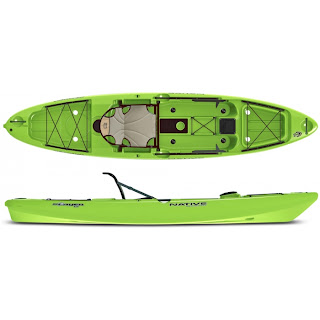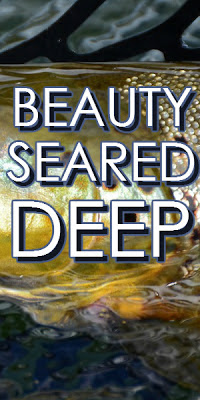 Yesterday morning was rough on the water. I launched at 5AM to what I thought was 10 mph winds. As I rounded the first bend and tasted the first wave, I knew different. Luckily I was in a 13 foot long Hobie Revolution with Mirage Drive and could battle through odd wave angles, two to three foot rollers and a nasty head wind to make my destination, but a few years ago, I didn't have a kayak with these attributes. A few years ago I heard the footsteps of death bounding for me as a freak, unannounced storm rolled in and tried to show me my maker.
Yesterday morning was rough on the water. I launched at 5AM to what I thought was 10 mph winds. As I rounded the first bend and tasted the first wave, I knew different. Luckily I was in a 13 foot long Hobie Revolution with Mirage Drive and could battle through odd wave angles, two to three foot rollers and a nasty head wind to make my destination, but a few years ago, I didn't have a kayak with these attributes. A few years ago I heard the footsteps of death bounding for me as a freak, unannounced storm rolled in and tried to show me my maker.Almost seven years ago now I embarked on an adventure. I was living in a new place with lots of new lakes, rivers and kayaking friends. One of these friends called me up last minute and wanted to go fish Lake Belton in our kayaks. Without hesitation I loaded up my 10 foot long sit in kayak and headed to the lake.
Lake Belton is full of large bluffs that tower above the water sometimes 50 feet. The bluffs make great shade to fish in during the boiling months of summer and this particular day called for shade. We trolled lures up and down the bluffs, staying in the shade as much as possible and being new, I trailed about two hundred yards behind my friend. I wanted to see what trees to avoid in the water and not lose any tackle.
The paddling and trolling was producing some white bass and an occasional hybrid so the time melted away. A huge jerk on my crankbait grabbed my attention and almost freed me of my rod. The kayak spun around quickly and I soon learned I had found a tree. I didn't want to lose the bait so I commenced the wizardry of trying to free a crankbait with no bait retriever that is lodged 12 feet below your kayak. After 10 minutes I finally freed the bait, looked up and my friend was gone. He must have kept going and rounded a corner into a nearby creek. With the bluffs blocking my view I could only paddle and try to catch a glimpse of where he had gone.
With the first paddle stroke I heard it. Closely behind it was another one. A loud, low booming sound filled the sky. I thought at first it was cannon fire on Ft Hood but as I listened further I knew this was a storm. With a zero percent chance of rain in the forecast my eyes tried to quickly readjust as the sky turned an angry charcoal. The wind found its breath and started frothing the water around me. Ahead I could see a small gravel bar and an overhang in the bluff wall. I leaned into my stroke and powered ahead.The sky released her hold on the rain and a torrential shower commenced.
With each stroke waves were pounding me from every side, rain blistering my face and water was collecting in the cockpit. After five minutes of paddling I had lost ground. Making no progress I headed the opposite direction, hoping the wind would help. Just trying to turn the kayak was a chore as the water was pocket high inside. I was wearing a life jacket and decisions had to be made. I decided to get into the water. I would try to tow the kayak while swimming to a small shelf I hadn't seen previously. Holding to the kayak handle the wind blew my plans away. The kayak, free of my weight was skimming across the waves. Before I could touch the bottom I had been blown 200 yards from my original position. With a more gradual slope than the steep bluff I had been near, I climbed onto the gravel bank and proceeded to flip the kayak to drain it. I sat exhausted in the pouring rain. The rain tasted salty. And then it hit me. I was crying. Scared, shaken and alone I was crying.
The old, flood-killed trees of this embankment creaked and moaned in the wind as I heard the most haunting sound I have ever heard in my life. The footsteps of death. I had very little fight left in me at this point but I was glad to be alive. The echoing booms of thunder and sprays of lightning filled the sky getting louder and brighter each second. The footsteps were drawing near. It was time to fight for my life. Another decision had to be made.
I quickly surveyed the landscape and discovered a small rock ledge that was as far away from the trees as possible. Trees are lightning magnets and I wanted no part of their potential light show. Wedging myself as deep under the ledge as I could get, I held my knees and my breath. The footsteps were getting closer. With an explosion and searing bright light a tree fell to its final resting place less than five yards away from my ledge. The ringing of my ears blocked out the thunder and I closed my eyes. If it was going to be today, I didn't want to see it coming.
As the ringing subsided a few minutes later I realized the footsteps were gone. Small rays of sunshine were peaking through and painting the now calming water. I remember thinking, "Today was not my day to go."
After surveying the skies, I emptied my kayak one last time, reboarded and went searching for my friend. In short order I discovered him around a bend, alert ok and fishing again. Apparently his time with the storm had not been as much of an ordeal. He casually asked if I was ok. I responded yes and then told him I thought I would call it a day.
























